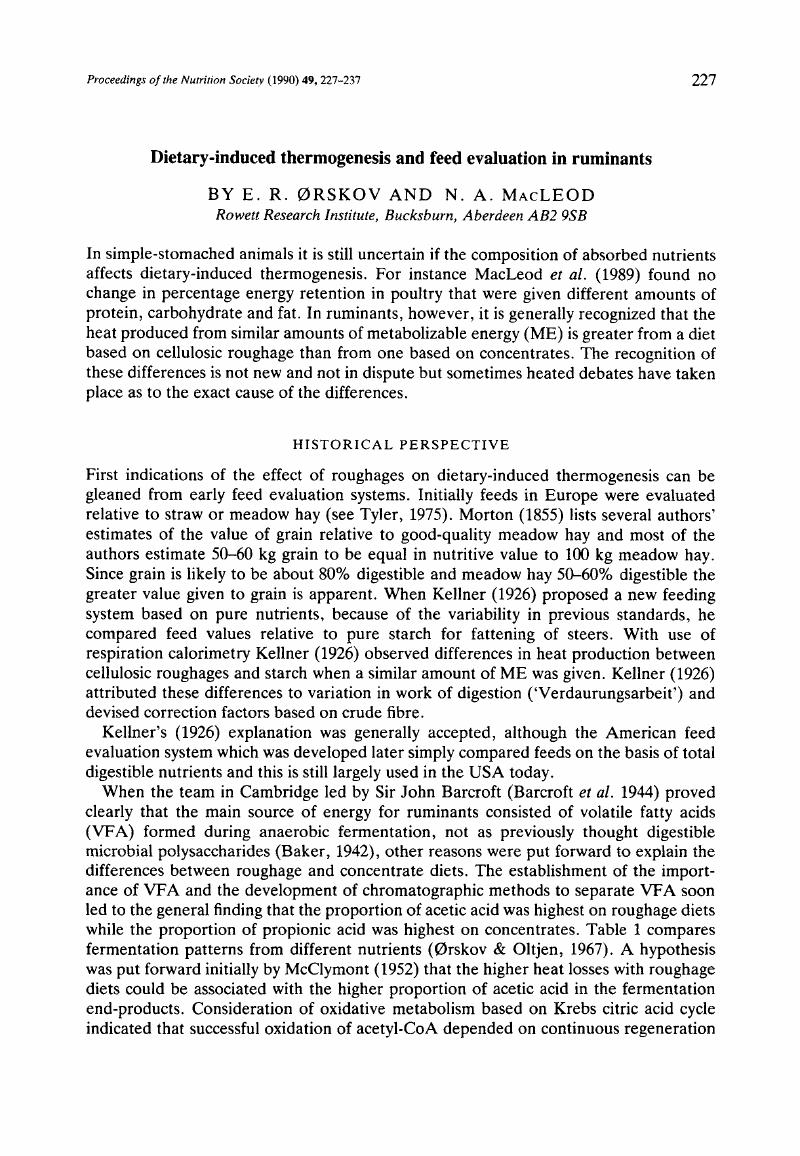Crossref Citations
This article has been cited by the following publications. This list is generated based on data provided by Crossref.
Ryle, M.
and
Ørskov, E. R.
1990.
Energy Nutrition in Ruminants.
p.
84.
Ørskov, E. R.
and
Macleod, N. A.
1993.
Effect of level of input of different proportions of volatile fatty acids on energy utilization in growing ruminants.
British Journal of Nutrition,
Vol. 70,
Issue. 3,
p.
679.
van Houtert, M. F. J.
and
Leng, R. A.
1993.
The effect of supplementation with protein, lipid and propionate on nutrient partitioning in roughage-fed lambs.
Animal Science,
Vol. 56,
Issue. 3,
p.
341.
Steen, R. W. J.
Johnston, S. D.
Kilpatrick, D. J.
and
Chestnutt, D. M. B.
1998.
Responses in the growth of body components of finishing lambs to additional metabolizable energy supplied from either grass silage or concentrates.
Animal Science,
Vol. 67,
Issue. 3,
p.
503.
Witt, M. W.
Sinclair, L. A.
Wilkinson, R. G.
and
Buttery, P. J.
1999.
The effects of synchronizing the rate of dietary energy and nitrogen supply to
the rumen on the production and metabolism of sheep: food characterization and
growth and metabolism of ewe lambs given food ad libitum.
Animal Science,
Vol. 69,
Issue. 1,
p.
223.
Steen, R.W.J.
and
Kilpatrick, D.J.
2000.
The effects of the ratio of grass silage to concentrates in the diet and restricted dry matter intake on the performance and carcass composition of beef cattle.
Livestock Production Science,
Vol. 62,
Issue. 2,
p.
181.
Agnew, R.E.
and
Yan, T.
2000.
Impact of recent research on energy feeding systems for dairy cattle.
Livestock Production Science,
Vol. 66,
Issue. 3,
p.
197.
Agnew, R E
Birnie, J W
Gordon, F J
and
Yan, T
2001.
The influence of body condition and level of feeding on the heat production of nonpregnant, nonlactating dairy cows.
Proceedings of the British Society of Animal Science,
Vol. 2001,
Issue. ,
p.
205.
Finegan, Esther J.
Buchanan-Smith, Jock G.
and
McBride, Brian W.
2001.
The role of gut tissue in the energy metabolism of growing lambs fed forage or concentrate diets.
British Journal of Nutrition,
Vol. 86,
Issue. 2,
p.
257.
Arieli, A.
Rubinstein, A.
Moallem, U.
Aharoni, Y.
and
Halachmi, I.
2004.
The effect of fiber characteristics on thermoregulatory responses and feeding behavior of heat stressed cows.
Journal of Thermal Biology,
Vol. 29,
Issue. 7-8,
p.
749.
Webster, JR
Stewart, M
Rogers, AR
and
Verkerk, GA
2008.
Assessment of welfare from physiological and behavioural responses of New Zealand dairy cows exposed to cold and wet conditions.
Animal Welfare,
Vol. 17,
Issue. 1,
p.
19.
Schroeder, G.F.
and
Titgemeyer, E.C.
2008.
Interaction between protein and energy supply on protein utilization in growing cattle: A review.
Livestock Science,
Vol. 114,
Issue. 1,
p.
1.
Aguilar-Pérez, Carlos Fernando
Ku-Vera, Juan Carlos
and
Magaña-Monforte, Juan Gabriel
2011.
Energetic efficiency of milk synthesis in dual-purpose cows grazing tropical pastures.
Tropical Animal Health and Production,
Vol. 43,
Issue. 4,
p.
767.
Galvani, D. B.
Pires, A. V.
Susin, I.
Gouvêa, V. N.
Berndt, A.
Chagas, L. J.
Dórea, J. R. R.
Abdalla, A. L.
and
Tedeschi, L. O.
2014.
Energy efficiency of growing ram lambs fed concentrate-based diets with different roughage sources.
Journal of Animal Science,
Vol. 92,
Issue. 1,
p.
250.
Josê Neto, Antônio
Granja-Salcedo, Yury Tatiana
Messana, Juliana Duarte
Malheiros, Euclides Braga
Reis, Ricardo Andrade
Pires, Alexandre Vaz
and
Berchielli, Telma Teresinha
2019.
Soybean hulls as feed substitute of ground corn can increase the fiber digestibility and bacterial fibrolytic profile of grazing Nellore steers during the rainy season.
Semina: Ciências Agrárias,
Vol. 40,
Issue. 6Supl3,
p.
3577.
Ren, Hao
Bai, Hanxun
Su, Xiaodong
Pang, Jie
Li, Xiaoyong
Wu, Shengru
Cao, Yangchun
Cai, Chuanjiang
and
Yao, Junhu
2020.
Decreased amylolytic microbes of the hindgut and increased blood glucose implied improved starch utilization in the small intestine by feeding rumen-protected leucine in dairy calves.
Journal of Dairy Science,
Vol. 103,
Issue. 5,
p.
4218.
Meehan, Denis J.
Cabrita, Ana R. J.
Maia, Margarida R. G.
and
Fonseca, António J. M.
2021.
Energy: Protein Ratio in Ruminants: Insights from the Intragastric Infusion Technique.
Animals,
Vol. 11,
Issue. 9,
p.
2700.
King, Tasha M
Beard, Joslyn K
Norman, Mitch M
Wilson, Hannah C
MacDonald, James M
and
Mulliniks, J Travis
2022.
Effect of protein and glucogenic precursor supplementation on forage digestibility, serum metabolites, energy utilization, and rumen parameters in sheep.
Translational Animal Science,
Vol. 6,
Issue. 1,



